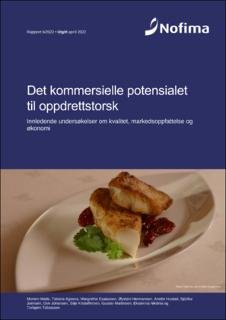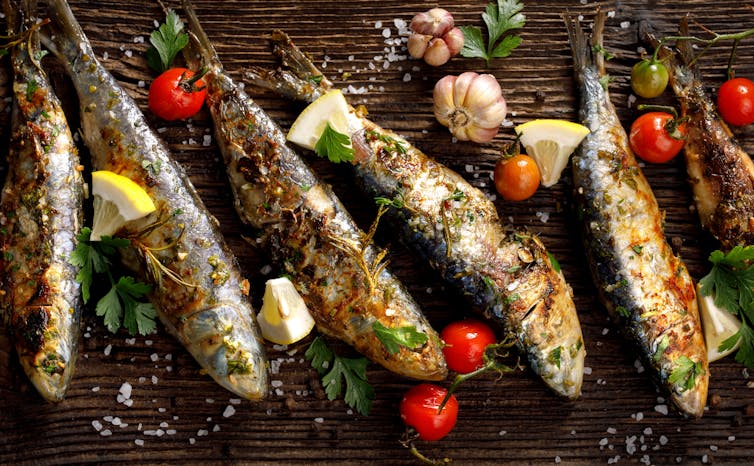by Anne-May Johansen, Nofima
Chefs in Tromsø give a thumbs up to the quality and taste of farmed cod. However, they would rather serve wild cod in their restaurants.

More information and knowledge about the story behind farmed cod will make it more relevant for restaurant menus.
Superusers of cod
Five Tromsø restaurants and their chefs have participated in a recent Nofima investigation which addresses the commercial potential of farmed cod – both in terms of quality, market perception and economy.
The chefs that took part in the interviews had between 15 and 26 years of experience preparing seafood in a professional context. All respondents can therefore be described as superusers of cod. None of them had previously worked with farmed cod.
“They were each sent a crate of fifth generation farmed cod from Nofima’s facility at Ringvassøya on the outskirts of Tromsø. Each crate contained approximately 25 kilograms of farmed cod. The fish were gutted and each weighed 3 to 4 kilograms including their head. The chefs received the fish only a few hours after they were slaughtered”, explains Morten Heide, market researcher at Nofima.
He has led the work on the recent report on farmed cod. Eleven Nofima scientists with different professional backgrounds have compiled the report.
The evaluation of farmed cod by the experienced chefs in Tromsø showed that the quality of whole fish, fillets and when cooked was generally perceived as good or very good.
“However, the chefs had divided opinions on farmed fish and would prefer to serve wild-caught fish. Nevertheless, several of the restaurants had farmed species on their menu, including Arctic char, trout, salmon, halibut and turbot”, says Morten Heide.
Stay Always Informed
Join our communities to instantly receive the most important news, reports, and analysis from the aquaculture industry.
Knowing the story is important
The results of the quality test are similar to those of the tests carried out on the first generation of farmed cod 19 years ago. Back then, most chefs were also of the opinion that the farmed cod was of good or very good quality.
All the chefs involved in the study were asked to evaluate the fish as gutted whole, filleted and as a cooked product. In addition, they were asked to complete a questionnaire about different product attributes, both of the fish and of a more general nature.
“In this year’s investigation, several of the chefs requested information about the farmed cod. They believed that more information could help them make qualified choices about whether or not to put farmed cod on the menu. Important factors are the content of the feed and sustainability, which will provide content to the story. Knowing the story was an important factor for all the chefs”, says Morten Heide.
Similar to the 2002 survey, a minority of the chefs were of the opinion that farmed cod had a ‘neutral’ taste.
This type of investigation is unable to determine whether this is due to the chef’s own preferences, that the farmed cod was very fresh, or that there is a real taste difference between wild and farmed cod”, Heide points out.
Consistently high quality and good availability
Several of the chefs stated that farmed cod of a similar quality to the fish used in the test could be interesting to use outside the winter season. Currently, they only have fresh cod on the menu every now and again during the rest of the year.
“Most chefs said they would have cod on the menu more often if availability and quality were good”, says Morten Heide.
The chefs believe that consistently high quality, good availability and deliverability are arguments that justify a good price for cod.
“A small majority were of the opinion that the price of farmed cod should be slightly lower than wild cod. This corresponds to the previous test carried out on farmed cod”, says Heide.
The chefs’ main purchasing criteria were:
- Quality, both texture and when the fish were caught/slaughtered
- Availability and season
- Size
- Type of product (pure loin of the correct size, whole fillets with skin on or other requirements)
- Price in relation to quality
- Firm, shiny and fresh
According to the five chefs, the characteristics of good quality cod were:
- Whole cod with head on must be firm and shiny. It must have a fresh sea smell and good colour to its gills.
- Cod fillets should preferably be firm, have good texture and be white and shiny.
- All the chefs mentioned that the cod should fall into flakes after it has been cooked. It had to be white, firm and keep its shape after being cooked. It should have a slightly sweet, mild taste.
Facts about the quality of farmed cod stated in the report:
- Whole farmed cod are characterised as having good condition factors regarding quality.
- The head is small in relation to the body. Skin colour is darker compared to wild-caught cod.
- No herring worm parasites were registered in the farmed cod.
- The fillet quality was good when the fish were filleted pre rigor (before rigor mortis sets in).
- When filleted after six days, the flesh was more prone to fillet gaping. The fish were gently filleted by hand during the trials. Overall, the fillet quality was satisfactory both in terms of colour and texture.
- The storage trials of gutted fish on ice showed that farmed cod has a shelf life that can be compared with what one might expect from cod.
Facts about the methods used:
- The investigation was carried out involving the fifth generation of farmed cod.
- The farmed cod were slaughtered in mid-November, while the wild cod were line-caught on Malangsgrunnen fishing grounds in early December 2021.
- The farmed cod were not fed for seven days before slaughter. The fish were bled and put on ice in crates before being transported to Nofima.
- The line-caught fish were bled on board, packed in ice and delivered to a fish processing facility, packed on ice in crates and transported to Nofima.
- At Nofima, all the fish were assessed and measured when whole and when gutted. Assessments were made of skin colour, fin damage, degree of sunburn, melanin spots, blood defects and liver colour. The yields of 12 farmed cod and 13 wild cod were measured.
- Storage trials were also carried out on farmed cod, including both fillets and gutted fish with heads on. Fillet quality was assessed after 0, 6, 10 and 13 days of storage.
Reference
Heide, Morten; Ageeva, Tatiana N; Esaiassen, Margrethe; Hermansen, Øystein; Hustad, Anette; Joensen, Sjurdur; Johansen, Ove; Kristoffersen, Silje; Nikitina, Ekaterina; Martinsen, Gustav; Tobiassen, Torbjørn I. 2022. The commercial potential for farmed cod – Preliminary studies on quality, market perception and economy. Nofima, Nofima rapportserie 6/2022.
Editor at the digital magazine AquaHoy. He holds a degree in Aquaculture Biology from the National University of Santa (UNS) and a Master’s degree in Science and Innovation Management from the Polytechnic University of Valencia, with postgraduate diplomas in Business Innovation and Innovation Management. He possesses extensive experience in the aquaculture and fisheries sector, having led the Fisheries Innovation Unit of the National Program for Innovation in Fisheries and Aquaculture (PNIPA). He has served as a senior consultant in technology watch, an innovation project formulator and advisor, and a lecturer at UNS. He is a member of the Peruvian College of Biologists and was recognized by the World Aquaculture Society (WAS) in 2016 for his contribution to aquaculture.




